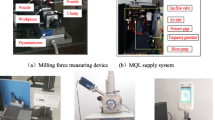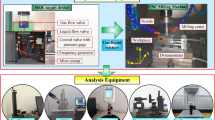Abstract
The conventional flood cooling is neither economically viable nor eco-friendly in the cutting process. The vegetable oil is biodegradable and environmentally friendly used as base oil for the minimum quantity lubricant (MQL) cutting, but the temperature field in the milling zone with different vegetable oils as lubricants remains unclear. The temperature of the MQL milling of the 45 steel was studied with cottonseed, palm, castor, soybean, and peanut oils as base oils. The effects of the fatty acid composition, carbon chain length, thermal conductivity, and viscosity on the milling temperature were also considered. The temperature distribution of the milling of the 45 steel with five different vegetable oils was simulated, showing that the cottonseed and the palm oils had good cooling effect. Experimental results were consistent with the findings obtained using the temperature simulation analysis. Compared with that of the flood milling, the temperature of the MQL milling with different vegetable oils decreased, and the temperature was reduced by 67.4% when the cottonseed oil was used. The surface quality of the workpiece was improved during the MQL milling. When the cottonseed oil was used as lubricant, the surface roughness (Ra) values decreased by 41.5%, 53%, and 50.2% when the cottonseed, palm, and castor oils, respectively, were used as lubricating fluids, which indicated that the advantages of biolubricants as base oils especially cottonseed, palm, and castor oils could be used as base oils for the MQL milling.












Similar content being viewed by others
Availability of data and materials
The datasets generated during and/or analyzed during the current study are available from the corresponding author on reasonable request.
Abbreviations
- MQLM:
-
Minimum quantity lubrication milling
- MQCL:
-
Minimum quantity cooling lubrication
- NMQL:
-
Nanoparticle minimum quantity lubrication
- VMQL:
-
Vegetable minimum quantity lubrication
- LAM:
-
Laser-assisted machining
- F x, F y , F z :
-
Cutting force component in the (x, y, z) directions (N)
- F max :
-
Mean milling force peak (N)
- \( {\overline{F}}_{\mathrm{max}} \) :
-
Average milling force peak (N)
- R a :
-
Arithmetic average height (μm)
- T :
-
Temperature (°C)
- t :
-
Time (s)
References
Zhong WW, Wang XB (2010) A comparative study on dry milling and little quantity lubricant milling based on vibration signals[J]. Int J Mach Tool Manu 50(12):1057–1064
Sharma J, Sidhu BS (2014) Investigation of effects of dry and near dry machining on AISI D2 steel using vegetable oil[J]. J Clean Prod 66(5):619–623
Ghuge NC, Dhatrak VK, Mahalle AM (2012) Minimum quantity lubrication[J]. Iosrjen 2(6):55–60
Davim JP, Sreejith PS, Gomes R (2006) Experimental studies on drilling of aluminium (AA1050) under dry, minimum quantity of lubricant, and flood-lubricated conditions[J]. P I Mech Eng B-J Eng 220(10):1605–1611
Thamizhmanii S, Hasan RS (2009) A study of minimum quantity lubrication on Inconel 718 Steel. AMSE 39(1):38–44
Fratila D (2009) Evaluation of near-dry machining effects on gear milling process efficiency[J]. J Clean Prod 17(9):839–845
Fratila, Domnita F (2009) Minimization of cutting fluids ecological impact by near dry machining. Environ Eng Manag J 8(2):335–339
Silva D, L R, Bianchi EC, Fusse RY, Catai RE, França TV, Aguiar PR (2006) Analysis of surface integrity for minimum quantity lubricant—MQL in grinding. Int J Mach Tool Manu 47(2):412–418
Zhang S, Li JF, Wang YW (2012) Tool life and cutting forces in end milling Inconel 718 under dry and minimum quantity cooling lubrication cutting conditions. J Clean Prod 32:81–87
Thepsonthi T, Hamdi M, Mitsui K (2009) Investiga on into minimal-cutting-fluid application in high-speed milling of hardened steel using carbide mills. Int J Mach Tool Manu 49(2):156–162
Sharma AK, Tiwari AK, Dixit AR (2016) Effects of minimum quantity lubrication (MQL) in machining processes using conventional and nanofluid based cutting fluids: a comprehensive review. J Clean Prod 127:1–18
Qin X, Gui LJ, Li H (2012) Feasibility study on the minimum quantity lubrication in high-speed helical milling of Ti-6Al-4V. J Adv Mech Des Syst 6(7):1222–1233
Dong L, Li CH, Bai XF (2019) Analysis of the cooling performance of Ti-6Al-4V in minimum quantity lubricant milling with different nanoparticles. Int J Adv Manuf Technol 103(5-8):2197–2206
Park KH, Yang GD, Lee MG (2014) Co-friendly face milling of titanium alloy. Int J Precis Eng Manuf 15(6):1159–1164
Li BK, Li CH, Zhang YB, Wang YG, Jia DZ, Yang M (2016) Grinding temperature and energy ratio coefficient in MQL grinding of high-temperature nickel-base alloy by using different vegetable oils as base oil. Chin J Aeronaut 29(4):1084–1095
Araujo J, Antonio S, Sales WF, Silva D, Rosemar B (2017) Lubri-cooling and tribological behavior of vegetable oils during milling of AISI 1045 steel focusing on sustainable manufacturing. J Clean Prod 156:635–647
Schuch B, Carlos A, Souza G, Janaina F, Gomes J, Oliveira (2015) The Jatropha curcas vegetable base soluble cutting oil as a renewable source in the machining of aluminum alloy 7050-T7451. Ind Lubr Tribol 67(2):181–195
Okada M, Hosokawa A, Asakawa N (2014) End milling of stainless steel and titanium alloy in an oil mist environment. Int J Adv Manuf Technol 74(9-12):1255–1266
Park KH, Yang GD, Suhaimi MA (2015) The effect of cryogenic cooling and minimum quantity lubrication on end milling of titanium alloy Ti-6Al-4V. J Mech Sci Technol 29(12):5121–5126
Kuram E, Ozcelik B, Demirbas E (2013) Environmentally friendly machining: vegetable based cutting fluids. Green Manuf Process Syst 10:23–47
Julie ZZ, Rao PN, Eckman M (2012) Experimental evaluation of a bio-based cutting fluid using multiple machining characteristics. IJME 12(1-2):35–44
Shashidhara YM, Jayaram SR (2010) Vegetable Oils as a Potential Cutting Fluid—an Evolution. Tribol Int 43(5–6):1073–1081
Sujan D, Moola MR, Qua SY (2014) Environmental friendly cutting fluids and cooling techniques in machining: a review. J Clean Prod 83:33–47
Xavior MA, Adithan M (2009) Determining the influence of cutting fluids on tool wear and surface roughness during turning of Aisi 304 austenitic stainless steel. J Mater Process Technol 2:900–909
Lopes JC, Garcia MV, Volpato RS et al (2020) Application of MQL technique using TiO2 nanoparticles compared to MQL simultaneous to the grinding wheel cleaning jet, The International Journal of Advanced Manufacturing Technology. 106(5):2205–2218
Garcia MV, Lopes JC, Diniz AE, et al (2020) Grinding performance of bearing steel using MQL under different dilutions and wheel cleaning for green manufacture. 257
Li M, Tianbiao Y, Yang L et al (2019) Parameter optimization during minimum quantity lubrication milling of TC4 alloy with graphene-dispersed vegetable-oil-based cutting fluid. J Clean Prod 209:1508–1522
Yin QA, Li CH,Dong L, Bai XF, Zhang YB, Yang M, Jia DZ, Li RZ, Liu ZQ (2021) Efects of Physicochemical Properties of Diferent Base Oils on Friction Coefcient and Surface Roughness in MQL Milling AISI 1045. INT J PR ENG MAN-GT. Published on line 10 February 2021045. https://doi.org/10.1007/s40684-021-00318-7
Zhang YB, Li CH, Jia DZ, Li BK, Wang YG, Yang M, Hou YL, Zhang XW (2016) Experimental study on the effect of nanoparticle concentration on the lubricating property of nanofluids for MQL grinding of Ni-based alloy. J Mater Process Technol 232:100–115
Zhang YB, Li CH, Yang M, Jia DZ, Wang YG, Li BK, Hou YL, Zhang NQ, Wu QD (2016) Experimental evaluation of cooling performance by friction coefficient and specific friction energy in nanofluid minimum quantity lubrication grinding with different types of vegetable oil. J Clean Prod 139:685–705
Junbo Zhou, Yang Liu (2012) FLUENT 6.3 Flow field analysis, China Machine Press.
Zhenjing Duan, Changhe Li, Wenfeng Ding, Yanbin Zhang, Min Yang, Teng Gao, Huajun Cao, Xuefeng Xu, Dazhong Wang, Cong Mao, Hao Nan Li, Gupta Munish Kumar, Zafar Said, Sujan Debnath, Muhammad Jamil, Hafiz Muhammad Ali (2021) Milling Force Model for Aviation Aluminum Alloy: Academic Insight and Perspective Analysis. Chinese Journal of Mechanical Engineering 34(1)
Yin QA, Li CH, Zhang YB (2018) Spectral analysis and power spectral density evaluation in Al2O3 nanofluid minimum quantity lubrication milling of 45 steel. Int J Adv Manuf Technol 7(1-4):129–145
Zhang YK (2015) Determination of thermal conductivity and research of heat transfer performance of the edible vegetables oil, Henan University of Technology
Li B, Li C, Zhang Y, Wang Y, Jia D, Yang M (2016) Grinding temperature and energy ratio coefficient in MQL grinding of high-temperature nickel-base alloy by using different vegetable oils as base oil. Chin J Aeronaut 29(4):1084–1095
Zhang Y, Li C, Jia D, Zhang D, Zhang X (2015) Experimental evaluation of MoS2 nanoparticles in jet MQL grinding with different types of vegetable oil as base oil. J Clean Prod 87:930e940
Zhang Y, Li C, Yang M, Jia D, Wang Y, Li B, Hou Y, Zhang N, Wu Q (2016) Experimental evaluation of cooling performance by friction coeffificient and specifific friction energy in nanoflfluid minimum quantity lubrication grinding with different types of vegetable oil. J Clean Prod 139:685–705
Liu HQ (1993) Correlation of liquid viscosity with thermal conductivity. Petrochem Technol 2:006
Quinchia LA, Delgado MA, Franco JM, Spikes HA, Gallegos C (2012) Low temperature flflow behaviour of vegetable oil-based lubricants. Ind Crop Prod 37(1):383–388
Guo S, Li C, Zhang Y et al (2016) Experimental evaluation of the lubrication performance of mixtures of castor oil with other vegetable oils in MQL grinding of nickel-based alloy[J]. J Clean Prod 140:1060–1076
Guo S, Li C, Zhang Y, Yang M, Jia D, Zhang X, Liu G, Li R, Bing Z, Ji H (2018) Analysis of volume ratio of castor/soybean oil mixture on minimum quantitylubrication grinding performance and microstructure evaluation by fractal dimension[J]. Ind Crop Prod 111:494–505
Lu N, Liang Z, Wan R, Han G (1986) Study on diesel engine fueled with vegetable oil. J Shenvang Agric Univ 17:65–72
Wang Y, Li C, Zhang Y, Yang M, Li B, Jia D, Hou Y, Mao C (2016) Experimental evaluation of the lubrication properties of the wheel/workpiece interface in minimum quantity lubrication (MQL) grinding using different types of vegetable oils[J]. J Clean Prod 127:487–499
Emami M, Sadeghi MH, Sarhan AAD, Hasani F (2014) Investigating the minimum quantity lubrication in grinding of Al2O3, engineering ceramic[J]. J Clean Prod 66(3):632–643
Funding
This research was financially supported by the National Natural Science Foundation of China (51806112 and 51575290); Scientific Research Development Project of Shandong Higher Education Institutions, China (J17KB016 and J18KA017); Technology Project of Qingdao Binhai University (2019KY02, 2020KY06); and Shandong Provincial Natural Science Foundation, China (ZR2017PEE002 and ZR2017PEE011).
Author information
Authors and Affiliations
Contributions
All authors named on the manuscript have made a significant to the writing, concept, execution, or interpretation of the work represented.
Corresponding authors
Ethics declarations
Ethical approval
This chapter does not contain any studies with human participants or animals performed by any of the authors.
Consent to participate
Not applicable for that section.
Consent to publish
All authors have read and agreed to the published version of the manuscript.
Competing interests
The authors declare no competing interests.
Additional information
Publisher’s note
Springer Nature remains neutral with regard to jurisdictional claims in published maps and institutional affiliations.
Rights and permissions
About this article
Cite this article
Dong, L., Li, C., Zhou, F. et al. Temperature of the 45 steel in the minimum quantity lubricant milling with different biolubricants. Int J Adv Manuf Technol 113, 2779–2790 (2021). https://doi.org/10.1007/s00170-021-06708-0
Received:
Accepted:
Published:
Issue Date:
DOI: https://doi.org/10.1007/s00170-021-06708-0




